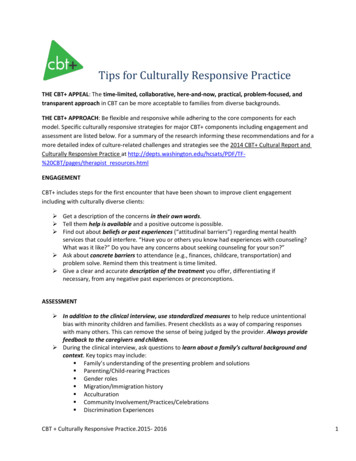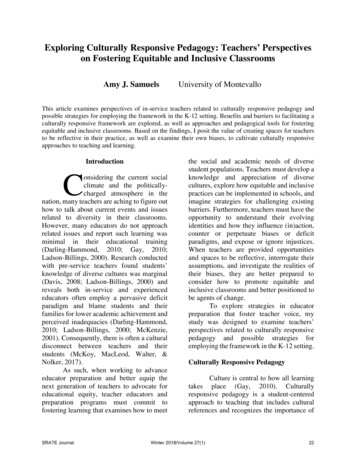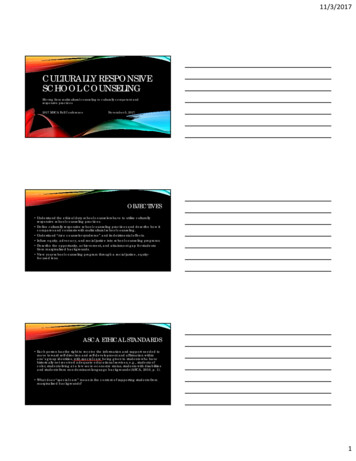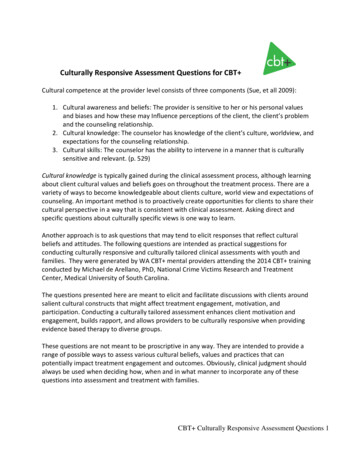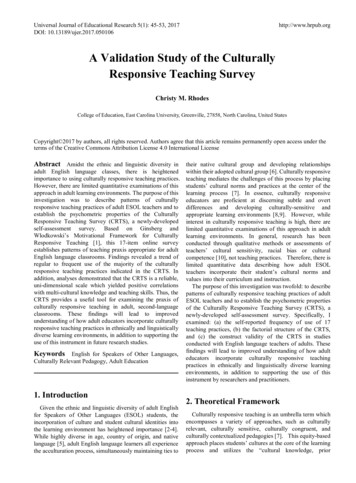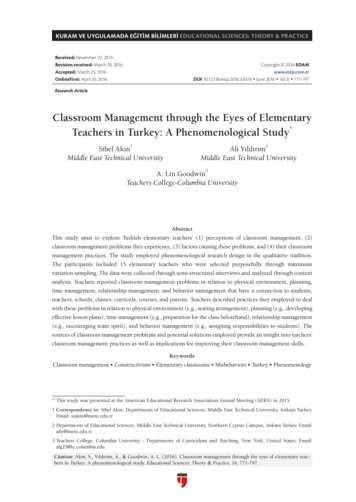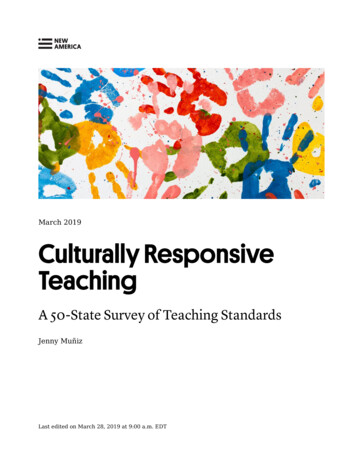
Transcription
March 2019Culturally ResponsiveTeachingA 50-State Survey of Teaching StandardsJenny MuñizLast edited on March 28, 2019 at 9:00 a.m. EDT
AcknowledgmentsThis report benefited from the invaluable expertiseand editorial insight of New America colleaguesSabrina Detlef, Amaya Garcia, Elena Silva, andMelissa Tooley. Special thanks to Alexandra Manueland Saroja Warner for reviewing drafts of the paper.Thank you to the many state leaders who generouslyshared information about their state’s teachingstandards. And particular thanks go to EmmaColeman, Riker Pasterkiewicz, and Maria Elkin forlayout and communication support. New America’sPreK–12 team is generously supported by the Bill &Melinda Gates Foundation, the Heising-SimonsFoundation, the Hewlett Foundation, the W.K.Kellogg Foundation, the McKnight Foundation, andthe W. Clement and Jessie V. Stone Foundation. Theviews expressed in this report are those of its authoralone and do not necessarily reflect the views ofthese foundations. If you have any questions aboutthis report, please contact y/reports/culturally-responsive-teaching/2
About the Author(s)Jenny Muñiz is a program associate with theEducation Policy program at New America. She is amember of the English learner education team,where she provides research and analysis on policiesand practices related to English learners, culturallyresponsive education, and educational equity.About New AmericaWe are dedicated to renewing America by continuingthe quest to realize our nation’s highest ideals,honestly confronting the challenges caused by rapidtechnological and social change, and seizing theopportunities those changes create.About Education PolicyWe use original research and policy analysis to helpsolve the nation’s critical education problems,crafting objective analyses and suggesting new ideasfor policymakers, educators, and the public at urally-responsive-teaching/3
ContentsIntroduction6Understanding Culturally Responsive Teaching9What is Culturally Responsive Teaching?9What Does Research Say About Culturally Responsive Teaching?10Who is Culturally Responsive Teaching for?11Teacher Competencies that Promote Culturally Responsive Teaching12Using Professional Teaching Standards to Promote Culturally ResponsiveTeaching16Culturally Responsive Teaching in National Models16Freestanding Culturally Responsive Teaching Standards17Professional Standards and Alignment18Integration of CRT in State Professional Teaching StandardsGathering and Analyzing Standards2020Findings: Culturally Responsive Teaching Competencies Across States20Excerpts from Excellent Teaching Standards /culturally-responsive-teaching/4
Contents Cont'dConclusions and Recommendations35Appendix A: Methodology38Appendix B: Overview of State Teaching /culturally-responsive-teaching/5
IntroductionFor the first time in our history, students of color make up the majority of1students enrolled in U.S. public schools. Yet 65 years after Brown tried to pave afair path for these students, the promise of educational equity remains elusive.Too many students of color are languishing in under-resourced schools, wherethey lack access to high-level academic courses, enrichment opportunities,2quality materials, and adequate facilities. These resource inequities only beginto scratch the surface, however. It is also the case that too many students of colorare held to lower academic standards, subjected to harsh discipline approaches,3and taught in ways that overlook or discount their cultural and linguistic assets.These and other barriers give way to massive imbalances in academicperformance that serve to limit students' life opportunities.Building a diverse pool of educators who are prepared to demonstrate culturally4responsive teaching or relevant teaching (herein CRT) is critical to reversingunderachievement and unlocking the potential of students of color as well as thatof other groups of underserved learners. Culturally responsive teaching is anapproach that challenges educators to recognize that, rather than deficits,students bring strengths into the classroom that should be leveraged to makelearning experiences more relevant to and effective for them. Adopting CRT goesbeyond celebrating students’ cultural traditions once a year. Educators whopractice CRT set rigorous learning objectives for all of their students and theycontinually build helpful bridges between what students need to learn and theirheritage, lived realities, and the issues they care about. In short, culturallyresponsive teaching is about weaving together rigor and relevance.What is needed now is a major investment indeveloping culturally responsive educators, onethat goes beyond providing one-off courses orworkshops.The need for culturally responsive teaching is more pressing than ever before,especially when you consider the deep demographic gaps between teachers andstudents. A teaching workforce that remains overwhelmingly female, white,middle-class, and monolingual is increasingly likely to teach students who are ofa different race, ethnicity, socio-economic status, language group, and so lly-responsive-teaching/6
Teachers are the drivers of culturally responsive practices in schools andclassrooms. But without the appropriate training and support, even the mostwell-meaning teachers can unwittingly provide instruction that is irrelevant,5ineffective, and even antagonistic to today’s diverse learners. Researchconcludes that recruiting a more racially diverse teaching workforce can6dramatically improve cultural responsiveness in schools, but demographic7parity is unlikely to be achieved in the coming years. Therefore, all teachers,regardless of background, benefit from support in reaching the diverse learnersthey are likely to serve.Unfortunately, teacher preparation programs and professional developmentsystems across the country are not sufficiently preparing educators to bring CRTto life in the classroom. Consider: while some educator preparation programs are8now required to offer coursework on teaching diverse students, these courses9are often narrow and disconnected from the mainstream curriculum. In-servicesupport and development fall short as well, as confirmed by teachers themselves.For instance, a 2018 survey of New York City teachers conducted by theMetropolitan Center for Research on Equity and the Transformation of Schools,found that fewer than one in three teachers had received ongoing professional10development on how to address issues of race and ethnicity in the classroom.Culturally responsive teaching is about weavingtogether rigor and relevance.What is needed now is a major investment in developing culturally responsiveeducators, one that goes beyond providing one-off courses or workshops.Developing comprehensive professional teaching standards that incorporateexpectations for CRT is a foundational step state leaders can take to bolster thefocus of CRT in current systems of teacher preparation and development. Notonly would such standards ensure that teachers receive clear and consistentmessaging about the knowledge, skills, and mindsets needed to be culturallyresponsive throughout their careers—they would also establish CRT as a formalstate priority. Though not a panacea, comprehensive state-level professionalteaching standards offer an opportunity to send a bold message that far frombeing an "add-on" initiative, CRT is integral to the work of all quality teachers.New America analyzed professional teaching standards in all 50 states to betterunderstand whether states’ expectations for teachers incorporate culturallyresponsive teaching. To support this analysis, we identify eight competencies ally-responsive-teaching/7
clarify what teachers should know and be able to do in light of research onculturally responsive teaching. Our research finds that while all states alreadyincorporate some aspects of culturally responsive teaching within theirprofessional teaching standards, the majority of states do not yet provide adescription of culturally responsive teaching that is clear or comprehensiveenough to support teachers in developing and strengthening their CRT practicethroughout their careers. As an added resource, we have assembled excerptsfrom state standards in which CRT is already well articulated, as well a datavisualization that describes the prevalence of CRT competencies in teachingstandards across turally-responsive-teaching/8
Understanding Culturally Responsive TeachingWhile the term culturally responsive teaching is gaining popularity, what thisapproach actually means often depends on who you ask. Researchers have raisedconcerns that, without the proper guidance, education leaders and individualeducators can adopt simplistic views of what it means to teach in culturally11responsive ways. Moving forward therefore requires that educators and thosewho support their efforts have a coherent understanding of what culturallyresponsive teaching does and does not entail.What is Culturally Responsive Teaching?Several frameworks exist for culturally responsive approaches (e.g., culturallyresponsive education, culturally relevant teaching, and culturally congruentteaching), each outlining various components. Capturing the history and broadbase of scholarship on CRT is not possible here as there are decades of researchand analysis. However, outlining the seminal work of key scholars and teachereducators Gloria Ladson-Billings, Geneva Gay, and Django Paris is a necessary12starting point.Over two decades ago, Gloria Ladson-Billings introduced the term culturallyrelevant pedagogy to describe a form of teaching that calls for engaging learnerswhose experiences and cultures are traditionally excluded from mainstreamsettings. Based on her research of effective teachers of African Americanstudents, Ladson-Billings proposed three goals on which these teachers’ practiceswere grounded. First, teaching must yield academic success. Second, teachingmust help students develop positive ethnic and cultural identities whilesimultaneously helping them achieve academically. Third, teaching must supportstudents’ ability “to recognize, understand, and critique current and social13inequalities.” By centering these goals in their practice, culturally relevantpractitioners can empower students not only intellectually but also socially,emotionally, and politically.Building on the work of Ladson-Billings, Geneva Gay developed a frameworkwith a stronger focus on teachers’ strategies and practices—that is, the doing ofteaching. Gay coined the term culturally responsive teaching to define an approachthat emphasizes “using the cultural knowledge, prior experiences, frames ofreference, and performance styles of ethnically diverse students to make14learning encounters more relevant to and effective for them.” Gay calls onculturally responsive practitioners to make positive changes on multiple levels,including instructional techniques, instructional materials, student-teacherrelationships, classroom climate, and self-awareness to improve learning forstudents. Gay argues that an asset-based view of students is fundamental ly-responsive-teaching/9
ensuring a higher degree of success from students of various cultural groups. LikeLadson-Billings, Gay also places a strong emphasis on providing opportunities forstudents to think critically about inequities in their own or their peers’experience.These scholars promote asset-based approaches asalternatives to popular deficit-oriented teachingmethods, which position the languages, cultures,and identities of students as barriers to learning.More recently, Django Paris expanded on the work of culturally relevantpedagogy to develop a vision for culturally sustaining pedagogy, an approach thattakes into account the many ways learners' identity and culture evolve. In a 2014article, Paris and co-author H. Samy Alim posit that culturally sustainingeducators not only draw on but also sustain students’ culture—both static culture15(e.g., heritage ways, and home language) and evolving culture. In other words,culturally sustaining educators help students develop a positive cultural identitywhile teaching math, reading, problem-solving, and civics. Paris also offers a“loving critique” of CRT, arguing that relevance in the curriculum cannot, alone,16ensure students will be prepared to live in an increasingly diverse, global world.Paris and Alim maintain that culturally sustaining practice “has as its explicitgoal supporting multilingualism and multiculturalism in practice and perspective17for students and teachers.” This is an important goal at time when schools areincreasingly racially segregated and students are grappling with racially18motivated bullying.Collectively, these scholars promote asset-based approaches as alternatives topopular deficit-oriented teaching methods, which position the languages,cultures, and identities of students as barriers to learning. While thesepedagogies are not identical, they share a common goal: defy the deficit modeland ensure students see themselves and their communities reflected and valuedin the content taught in school.What Does Research Say About Culturally Responsive Teaching?Compelling research highlights the benefits of culturally responsive teaching. Forinstance, studies in brain science and education find that drawing on /culturally-responsive-teaching/10
background knowledge shapes comprehension; indeed, all learners process new19information best when it is linked to what they already know. Research alsoillustrates that instructional materials, assignments, and texts that reflectstudents’ backgrounds and experiences are critical to engagement and deep,20meaningful learning. A smaller, yet promising group of studies evaluating theeffectiveness of CRT interventions link this approach to a wide range of positiveoutcomes such as academic achievement and persistence, improved attendance,21greater interest in school, among other outcomes.Culturally responsive teaching also has critical synergies with other reformefforts in education, such as initiatives to improve school climate and implement22social-emotional learning. For instance, research shows that students whodevelop a positive sense of racial and ethnic identity are more interested in23befriending people of different backgrounds. Other studies have found that astrong racial-ethnic identity is linked to higher self-esteem, academic attitudes,24well-being, and the ability to navigate discrimination. Though more rigorous,25large-scale studies are needed, existing studies already support taking action toboost teachers' cultural responsive practice.Who is Culturally Responsive Teaching for?In a culturally responsive classroom, learners’ varied identities and experiencesare identified, honored, and used to bridge rigorous new learning. This type ofindividualized instruction benefits all students, which is why Gloria LadsonBillings titled her seminal text on culturally relevant pedagogy: “But That’s Just26Good Teaching!” However, culturally responsive teaching begs the question:Which students do not receive this type of culturally relevant instruction? ForLadson-Billings, the answer is African American students. It remains true that fartoo many black students have their cultural ways of knowing treated as barriers inthe learning process, they have their ability and potential questioned, and they27encounter educators who proclaim: “I don’t see color!”Several scholars have expanded on Ladson-Billings’ framework to addresslearners with other varying and intersecting identities (including based on socialclass, English proficiency, disability status, LGBTQ status) whose identities and28experiences are likewise excluded from mainstream settings. It is clear thatthese students can also benefit from “mirrors" that allow them to see themselves,their experiences, and their communities in school. For these and other studentsculturally responsive teaching also provides critical “windows” into the culturalheritage and experiences of others. In an increasingly diverse society, allstudents benefit from learning to honor their own, and one another’s culturalheritage and lived culturally-responsive-teaching/11
Teacher Competencies that Promote CulturallyResponsive TeachingBringing together insights from extensive research on culturally relevant,responsive, and sustaining pedagogies, New America developed eight commoncompetencies of culturally responsive educators (see Figure 1). Though not anexhaustive list, these interconnected competencies illustrate the common skillsand knowledge that research and theory in the field suggests are critical toenacting culturally responsive teaching with fidelity, across grade levels andsubject areas. These competencies were used to guide our scan of teachingstandards, which is described in Section 5 (“Integration of CRT in StateProfessional Teaching Standards”) of this report.Competency 1: Reflect on one’s cultural ally-responsive-teaching/12
Culturally responsive educators routinely reflect on their own life experiencesand membership in various social groups (such as by race, ethnicity, social class,and gender), and they ask themselves how these factors influence their beliefsabout cultural diversity. They understand that they, like everyone, canunwittingly adopt societal biases that can shape the nature of their interactionswith students, families, and colleagues. Therefore, they actively work to developcultural competency: understanding, sensitivity, and appreciation for the history,values, experiences, and lifestyles of other cultures. They also gain comforthaving critical conversations and challenging stereotypes and prejudices whenthey encounter them. Though becoming critical and self-aware can be difficultand uncomfortable, particularly for educators who have never explored theirethnic and racial identities, research shows that actions such as guided reflection,reflective journaling, and group discussions can help educators overcome those29feelings.Competency 2: Recognize and redress bias in the systemCulturally responsive educators seek to deepen their understanding of how socialmarkers (such as race, ethnicity, social class, and language) influence theeducational opportunities that learners receive. Sonia Nieto suggests thatteachers ask questions like: “Where are the best teachers assigned?” “Which30students take advanced courses?” and “Where are resources allocated?”Teachers further engage with literature and professional learning opportunitiesto learn more about how institutional racism and other forms of bias (e.g.,racism, sexism, homophobia, and classism) at an institutional level can result indisadvantaging some groups of learners while privileging others. Teachers whoare informed about institutional bias, accept that not all learners are equallyrewarded for their hard work. They advocate for the disruption of harmful schooland district-level practices, policies, and norms. Conversely, teachers who arepoorly informed about institutional biases may blame learners and perceivedcultural deficiencies for academic achievement disparities.Competency 3: Draw on students’ culture to share curriculum andinstructionCentral to culturally responsive teaching is the belief that students’ culturalbackground is a resource to learning. Believing this to be true, culturallyresponsive teachers plan learning encounters that validate students’ livedrealities, cultural identities, and heritage. Although school districts and schoolstraditionally select formal curricula, culturally responsive teachers strive toevaluate all textbooks and instructional materials they use to ensure they do notperpetuate stereotypes or fail to represent diverse groups. They complement thetraditional curriculum with examples, newspaper clippings, articles, song lyrics,plays, comics, video games, and other resources that reflect experiences,characters, settings, and themes their students can relate to. They deploy lturally-responsive-teaching/13
scaffolding by providing links between academic concepts and the experiencesthat are familiar to students. In addition to providing “mirrors” reflectingstudents’ familiar world, teachers provide “windows” into the history, traditions,and experiences of other cultures and groups.Competency 4: Bring real-world issues into the classroomCulturally responsive teachers address the “so what?” factor of instruction byhelping students see how the knowledge and skills they learn in school arevaluable for their lives, families, and communities. They ask: “What does thismaterial have to do with your lives?” “Does this knowledge connect to an issueyou care about?” and “How can you use this information to take action?”Culturally responsive educators employ lessons and regularly assign projects thatrequire learners to identify complex, real-world issues they encounter in theirdaily lives and propose solutions for these problems. For example, elementaryschool students might learn about environmental injustice and devise a plan for31cleaning up a local river; middle school students might learn to apply mathconcepts to an analysis of racial inequities in traffic stop data in their community;32and high school students might engage in a Socratic seminar to explore33solutions to the police brutality experienced by their community. Learners inthese culturally responsive classrooms, learn to see themselves as agents ofchange who aspire for a better world.Competency 5: Model high expectations for all studentsCulturally responsive educators adopt the view that all students are capable ofacademic success, a belief that research shows is critical to supporting student34growth. These educators do not assume some students will inevitablyunderperform on the basis of their race, culture, or other group difference. Theyunderstand that students of color and other marginalized students areparticularly vulnerable to negative stereotypes about their intelligence, academic35ability, and behavior, which can hobble their academic performance. Therefore,they support all students in producing high-level work by scaffolding instruction;for instance, by using culturally relevant materials (competency 3). Research hasidentified many other behaviors that communicate high expectations. Theseinclude using eye contact and proximity with both high-achieving and strugglinglearners; ensuring language, gestures, and expressions communicate thatstudents’ opinions are important; and of course, ensuring all students have36access to a rigorous core curriculum.Competency 6: Promote respect for students differencesCRT practices are best implemented in environments that are respectful,inclusive, and help learners value the cultures of their peers. Educatorscontribute to such learning environments by modeling how to engage acrossdifference and embodying respect for social, cultural, and linguistic s/culturally-responsive-teaching/14
Culturally responsive educators assess how learners from different backgroundsexperience the environment and encourage students to reflect on their ownexperience with bias. These educators help students develop a sense ofresponsibility in addressing mistreatment, prejudice, injustice, and bullyingwhen they encounter it. Research finds that when students face discrimination,they may develop feelings of frustration, anger, and unworthiness that can resultin low achievement, dropout tendencies, and behavioral problems. On the otherhand, a caring school community where students feel a sense of belonging can37contribute to stronger academic performance.Competency 7: Collaborate with families and the local community38A strong home-school partnership is critical to supporting academic success,but it can be difficult for educators to engage families and community members ifthere are demanding schedules, inconvenient meeting locations and times, or39past trauma in interfacing with school. Culturally responsive educators assumethat parents are interested in being involved in their children’s education andthey develop engagement strategies that are sensitive to the unique barriersfaced by immigrant families, families of color, and low-income families. Becauseschools have traditionally privileged the input and collaboration of families fromdominant backgrounds, culturally responsive educators aim to develop the trustof diverse families to ensure they are involved at all levels of their child’seducation throughout the year. Moreover, they continually seek to learn moreabout the local community as well as families and their cultures and values, andthey collaborate with local agencies and organizations to arrange resources forstudents and families. Overall, these educators see themselves as members ofthe community, and they see teaching as a way to give back to the community.Competency 8: Communicate in linguistically and culturally responsivewaysWhen educators communicate in culturally sensitive ways, students and familiesfeel more welcome and inclined to participate in schools. Too often, however,miscommunication can occur between white teachers who value passive andindirect, European styles of communication and students who come from40cultures that prefer frank, direct, and participatory styles of communication.The communication styles of black students, in particular, can be misconstrued41as adversarial or defiant, which can lead to over-disciplining. Therefore,culturally responsive teachers seek to understand how culture influencescommunication, both in verbal ways (e.g., the tone of voice, rhythm, andvocabulary usage) and nonverbal ways (e.g., the amount of space betweenspeaker and listener, eye contact, body movements, and gestures). Culturallyresponsive teachers also work to honor and accommodate home languages,including by advocating for translation services and resources in eports/culturally-responsive-teaching/15
Using Professional Teaching Standards to PromoteCulturally Responsive TeachingSince the 1990s, professional teaching standards have played an important rolein the way teachers are prepared and developed. Today, all 50 states useprofessional teaching standards to articulate what teachers in their state should42know and be able to do. States rely on professional standards to anchor teacherpreparation coursework, pre-service field experiences, licensure assessments,induction programming, systems of evaluation, and professional developmentrequirements for in-service growth and licensure renewal. Given their importantrole, professional teaching standards offer an opportunity to ensure a strongfocus on culturally responsive practices throughout teachers' careers. Severalnational organizations have made progress in embedding responsive teachingpractices into their own professional teaching standards. For their part, a fewstates have developed free-standing standards explicitly focused on teachers'cultural competencies. This section provides an overview of these efforts.Culturally Responsive Teaching in National ModelsIn 1992, the Council of Chief State School Officers’ (CCSSO) Interstate NewTeacher Assessment and Support Consortium (INTASC) articulated the ModelStandards for Beginning Teacher Licensing, Assessment and Development: A Resourcefor State Dialogue. These standards were revised in 2011, as the InTASC ModelCore Teaching Standards, to define what all teachers "should know and be able todo to ensure every K–12 student reaches the goal of being ready to enter college or43the workforce in today’s world.” In 2013, the Learning Progressions forTeachers were developed to supplement the InTASC Model Core TeachingStandards by describing levels of teacher practice across a continuum of44development, from beginning to advanced teaching.It is notable that the InTASC Model Core Teaching standards include a strongfocus on teaching diverse groups of learners. Standards now describe desirableteacher behaviors such as demonstrating respect for children’s cultures, offeringclassroom instruction that accommodates the cultures of the children in it, andavoiding personal bias when interacting with learners. The InTASC Model CoreTeaching Standards have gained currency in the field and are used by themajority of states in some way. For example, some states draw from thesestandards in developing their own, while others adopt these standards with nosignificant changes (see Appendix B for a list of standards reviewed for all 50states). The national accrediting body, Council for the Accreditation of EducatorPreparation (CAEP), endorses the InTASC Model Core Teaching Standards,ensuring all CAEP accredited preparation program across the country are aligned45to these culturally-responsive-teaching/16
To a lesser extent, standards developed by the National Board for ProfessionalTeaching Standards (NBPTS) have also informed the development of states’standards. Based on a comprehensive set of standards established in the late1980s by the NBPTS, initial National Board Certification is a rigorous processthat requires teachers to submit extensive evidence (videos, lesson plans, studentwork, reflections, etc.) of their positive e
For instance, a 2018 survey of New York City teachers conducted by the Metropolitan Center for Research on Equity and the Transformation of Schools, found that fewer than one in three teachers had received ongoing professional development on how to address issues of race and ethnicity in the classroom. Culturally responsive teaching is about .

